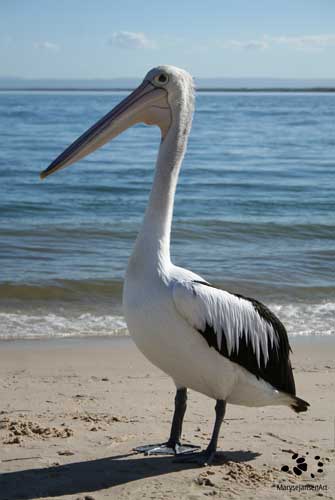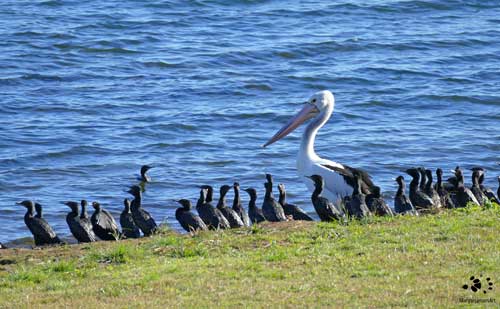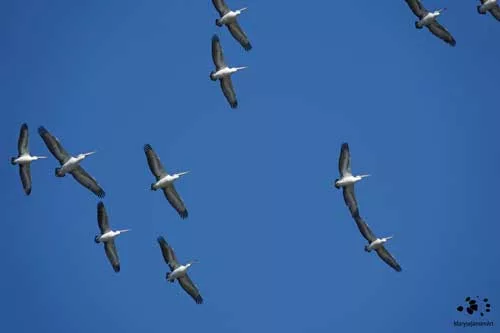Bird Photography with marysejansenart
A bird with multiple interesting features and behaviours

Table of Contents
Face to face with an Australian Pelican
Oh wow! I’m on the beach, turn around and find myself face to face with an Australian Pelican. And it is big! I’m no shortie, but I am looking it straight in the eye! Out of the 8 pelican species in the world, the Australian Pelican is the tallest. It can grow up to a height of 1.90m and has a wingspan of up to 2.5m. It weighs around 5.5kg on average, but this can range from 4-13kg! This makes it the second heaviest Australian flying bird, after the Brolga. Furthermore, it has the longest bill of any living bird, up to 50cm long. It is a very impressive bird!
This was my first encounter with an Australian Pelican and of course it had to be documented with my photo camera – you can see the result in the featured image. You can also see that this bird is mostly white, with black tips of the wings and tail. It has a yellow eye ring and the bill is yellow and has a pale pink pouch. The legs and feet are black.
Australian Pelicans are Opportunistic Feeders
These Pelicans feed on a wide range of prey, including aquatic crustaceans such as yabbies and prawns, insects, birds, eggs, reptiles, amphibians and mammals! But of course their favourite food is fish. Interestingly, they have a taste for introduced species such as goldfish and European Carp. So these birds can be a great help in mitigating these in Australian waters. Their love for fish attracts them to fishermen’s boats and jetties where they hope to catch some discarded fish and scraps.
When feeding, the pelican uses the pouch on its bill as a net. In one scoop it can collect up to 13 litres of water! Then it empties out the water by squeezing the pouch to its breast and the prey stays behind. The bird manoeuvres the prey around so that it can be swallowed head first. A sudden jerk of its head enables it to swallow the prey. You may encounter Australian Pelicans feeding alone or in a group. When hunting in a group, they are able to herd the fish into a shallow area or into a confined space.
I also regularly spot a pelican joining in the fishing spree of flocks of other birds, such as Little Black Cormorants. It is quite an entertaining sight. In the image below the birds are about to enter the water. The Cormorants are very excited! It looks like the large Pelican says ‘Come Along little birds!’ as if it is a kindy teacher, taking out a bunch of toddlers on a little trip!

Fascinating breeding habits
The breeding habits of the Australian Pelican are very interesting but not easily accessible to observe. Even though they breed in large colonies, they prefer to do so on islands or in other secluded places along the shore.
During courtship, the colouring of their bill changes drastically. The pouch becomes a bright half pink, half yellow. A cobalt blue colour adorns parts of the top and base of the bill and also puts a stripe on the pouch. The main surface of the bill turns pink. When you look closely, you may notice that the Pelican in the image above is in breeding colours! Maybe it’s dreaming about having lots of little pelican chicks to take out fishing! 😉
The courtship ritual is a parade, where a female pelican leads a group of male suitors around the colony on a walk. The males try to get her attention by by picking up small objects which they throw in the air and catch and by swinging their open bills from side to side. The last display is also used to threaten the other males. Both the female and the males clap their bills in rapid succession which creates ripples on the pouch. The males drop out one by one and the last one standing will be led to a nest site by the female.
The female pelican prepares the nest. She uses her bill and feet to scrape a dent in the ground and then lines it with soft items such as feathers and vegetation. She lays 1-3 eggs, each 2-3 days apart. The incubation takes 35 days and is shared by male and female. The chicks spend 28 days in the nest after they hatch. As the first chick is larger then its siblings it has the best chance to survive. It will take most of the food and grow faster and stronger. It may even kill its siblings.
Once ready to leave the nest, the young pelicans will form creches with up to 100 other chicks. They stay in there for 2 months after which they are ready to fly and look after themselves.
Soaring on the thermals

Wild Australian Pelicans can live for more then 25 years! They are widespread in most of Australia and inhabit freshwater, estuarine and marine wetlands. They travel far and wide in search of water, which offers them food. With their large wingspan they are well suited to take advantage of the thermals which take them to high altitudes. It is quite common for a pelican to fly at an altitude of 1,000m or more. With very little effort they can soar over large distances and they are able to remain in the air for 24 hours, travelling hundreds of kilometres. Mind blowing, don’t you think!?
I look up to see a flock of Australian Pelicans soaring overhead, circling higher and higher. They contrast superbly against the bright blue sky which has not a cloud in sight. What an amazing sight and a great photo and video opportunity! I wonder where they will go!
Check out the flying flock of pelicans in the latest episode of ‘Come for a walk in the Australian Bush’:
If you are interested in purchasing a print of the featured image ‘Australian Pelican’ or would like to see what the image looks like on the various merchandise products, please head to my shop. For ‘Come Along’, click here. If you prefer ‘Australian Pelicans in Flight’, click here.


